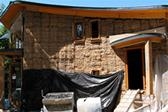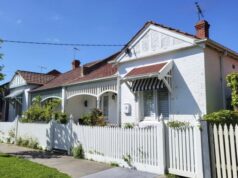
People have been making houses from straw bales for centuries. Straw bales can be remarkably effective insulators, but straw bale homes must be expertly constructed to avoid the risk of fire or rot.

Image by Colin Rose, used under the CC BY 2.0 license.
What is straw bale insulation?
While it may seem obvious from the name, straw bales are made of straw which has been compacted, cut and bound in a baling machine. The typical straw bale is bound twice and is approximately 900mm long, 350mm high and 450mm deep.
In a straw bale house, these bales form the walls, insulation and framework all in one, with some additional support from wooden beams wherever they’re necessary. The straw bales are normally then rendered with earth, cement or a similar material to seal in the straw and protect it on all sides from moisture seepage and potential fire damage.
Straw has been used as an insulator and structural material for centuries, and is even referenced as a building material in most versions of the tale of the Three Little Pigs. Thankfully though, today’s straw bale houses are a little more wolf-proof… Straw bale homes are uncommon, face unique problems in terms of construction and maintenance, and aren’t widely avaialbe for commecial construction.
How do straw bales provide insulation?
Straw is made of cellulose, which is a poor thermal conductor surrounding pockets of air, also a fairly poor thermal conductor. The sheer volume of the straw bale, in combination with the insulative qualities of the material account for its excellent thermal resistance.
How effective are straw bales for insulation?
Because the thickness of individual bales may vary slightly and the thickness and material of any render applied will also vary, it’s difficult to place exact R-values on how a given straw bale home will perform. Straw bale walls have achieved some extremely high R values though, and they certainly have the capacity to deliver in terms of thermal insulation.
How do straw bales perform in terms of soundproofing?
Again, because straw bale applications vary so widely it’s difficult to place exact measurements on how well they prevent sound transmission. The thickness of the bale and the fact that it is rendered on both sides will stop a great deal of sound transmission. Depending on the render, straw bale walls may echo and reflect some sound.
How are straw bales supplied and installed?
The bales are transported to the site and stacked into place according with the house plan. One side of the bale will be slightly thicker than the other, so it is important to keep this in mind when stacking or walls won’t be level. Straw bale homes face unique problems in terms of sealing off bales, waterproofing and ensuring structural integrity throughout to comply with building code requirements. In most cases the construction of these types of homes is a labour of love.
What does straw bale insulation cost?
Straw bale homes can vary widely in price, depending on factors like availability and cost to transport the materials, the choice of render material and labour costs. You’ll also spend more money proving your construction will meet the standards set out in the BCA. Straw bale homes are currently unregulated, so it’s ultimately down to the builder to demonstrate that the house will adhere to the code.
Special considerations
Straw bales by themselves are obviously flammable, but when rendered in a wall they can outperform other more common building materials in terms of fire resistance. Perhaps the biggest problem is finding experienced tradespeople who will work with a straw construction; careful thought and planning needs to go into how to approach things like electrical and plumbing installation and maintenance.





